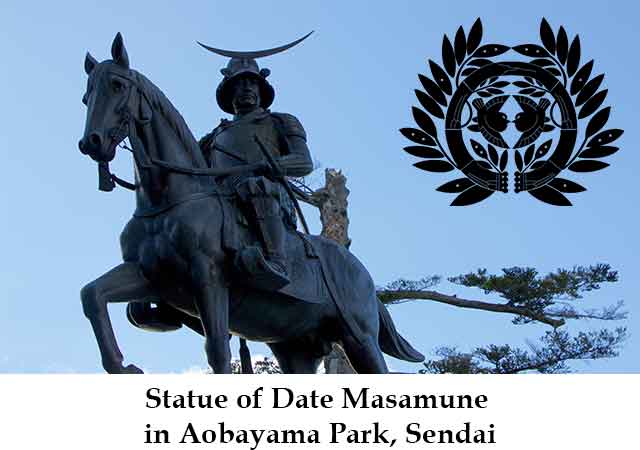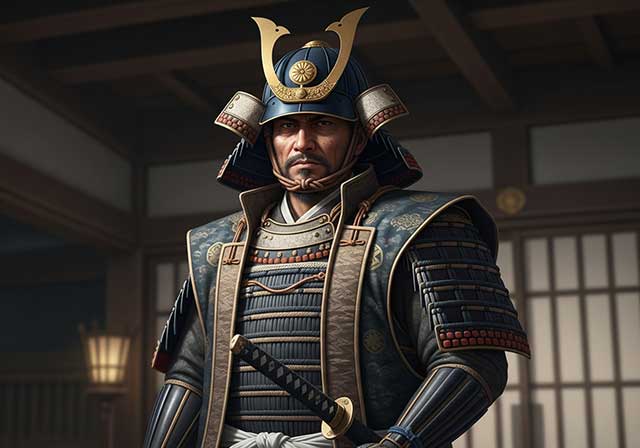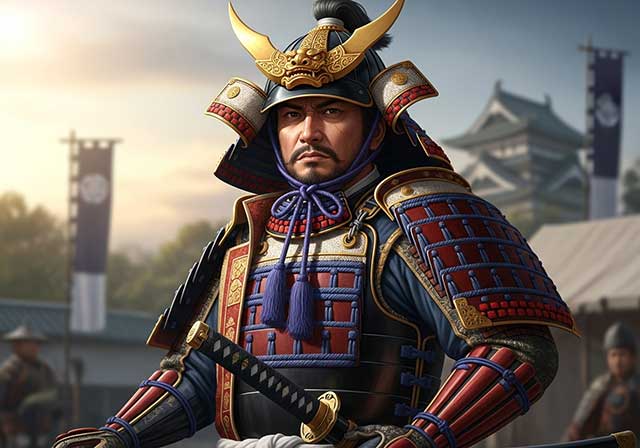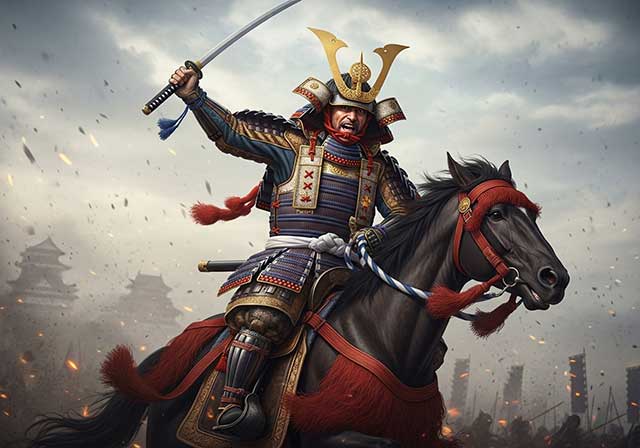
Date Masamune, renowned as the "One Eyed Dragon of the North" or Dokuganryu, was a formidable figure of the Sengoku period. He held the title of lord over Sendai and was distinguished for his tactical brilliance, fearless combat skills, and exceptional leadership. Amongst samurai circles, he was known for his loyalty, ethical conduct, ruthless determination, astute administration, and ambitious pursuits.
Born in Yonezawa Castle, now in Yamagata Prefecture, Masamune was the son of Date Terumune, the lord of Mutsu. Smallpox claimed his right eye during childhood, prompting its removal. This led his mother to deem him unfit to inherit leadership of the clan, advocating for his younger brother Kojiro instead. Matters took a dark turn when she attempted to poison Masamune, compelling him to take drastic measures. He had to end his brother's life to secure his own survival and maintain control.
Following his father's retirement, Masamune ascended to lead the Date clan, expanding its influence by conquering neighboring domains while consolidating his own. When the Hatakeyama clan couldn't resist Masamune's advances into their territory, they appealed to his father for intervention. Unable to rein in his son, Terumune was taken captive. Masamune, upon receiving this grim news during a hunting expedition, pursued the kidnappers and executed his own father on Terumune's orders. As further retribution, he ordered the families of the kidnappers to be tracked down, tortured, and executed.
In 1590, Toyotomi Hideyoshi, the nation's ruler, demanded Masamune's participation in the Siege of Odawara. Initially resistant, Masamune's eventual compliance angered Hideyoshi. Expecting execution for his initial defiance, Masamune presented himself before Hideyoshi, displaying no fear. To everyone's surprise, Hideyoshi spared his life, sensing potential use in the future. Masamune went on to demonstrate his loyalty during Hideyoshi's Korean campaigns.
Given lands at Iwadeyama by Hideyoshi, Masamune transformed the area into a thriving economic and political hub over 13 years. His financial acumen later turned Sendai from a modest fishing village into a prosperous city.
After Hideyoshi's passing, Masamune shifted his allegiance to Tokugawa Ieyasu, who granted him the Sendai Domain, purportedly yielding one million koku, though the actual output was 640,000 koku.
In the lead-up to the Battle of Sekigahara in 1600, Masamune supported the Tokugawa cause by engaging the Uesugi clan in the northern regions, enabling Ieyasu to focus on the growing Western allied forces. Although absent from the battlefield, Masamune's contributions greatly aided the Eastern victory.
After the Battle of Sekigahara, Date Masamune, along with 52,000 of his samurai and their families, moved from Iwadeyama to the village of Sendai.
Here, Masamune launched numerous public projects to enhance the land and embellish the Tohoku region, turning it into a sought-after tourist destination. He fostered trade, permitting foreign missionaries and traders to operate within his domain. He even utilized foreign shipbuilding techniques to construct the Date Maru, which embarked on Japan's inaugural diplomatic mission to the Philippines, Mexico, Spain, and Rome for an audience with the Pope, and to secure trading privileges with various nations along the route.
Masamune fathered 16 children, including two illegitimate ones, with his wife and seven concubines. His attire was characterized by relatively plain black armor and a distinctive helmet crest resembling a large, thin crescent moon. He is often depicted wearing a sword guard in place of an eye patch. Date Masamune passed away at the age of 68 on June 27, 1636.
See also
-
Hattori Hanzo

Hattori Hanzō, also known by the name Hattori Masanari, was the third son of Hattori Yasunaga, a samurai who served the Matsudaira clan. In his childhood he was called Tigachi Hanzō. His father held the highest rank in the shinobi hierarchy, that of jōnin, and Hanzō followed in his father’s footsteps, choosing the same path.
-
Hatano Hideharu

Hatano Hideharu was the eldest son of Hatano Harumichi, the head of the Hatano clan. However, in childhood he was adopted by his uncle, Hatano Motohide, and was therefore formally regarded as Motohide’s heir. From the time of Hideharu’s grandfather, Hatano Tanemichi, the Hatano clan had been a vassal of the powerful Miyoshi house, which exerted considerable influence over the Ashikaga shoguns and effectively shaped the political situation in the region. Early in his career, Hideharu served Miyoshi Nagayoshi and, judging by surviving records, held a fairly high position within his lord’s hierarchy, as he was among the select group invited to the enthronement ceremony of Emperor Ōgimachi in 1557.
-
Fukushima Masanori

Fukushima Masanori, a samurai from Owari Province, served Toyotomi Hideyoshi and took part in the Battle of Shizugatake, where he distinguished himself so conspicuously that he was awarded the honorary title of one of the “Seven Spears of Shizugatake,” meaning the warriors who had shown the greatest valor in the battle. As a reward for his courage and martial prowess, he was granted land producing an income of 5,000 koku of rice.
-
Uemura Masakatsu

Masakatsu was a member of the Uemura clan and the son of Uemura Masatada; from an early age he served Tokugawa Ieyasu. During the Ikkō-ikki uprising in Mikawa Province in 1563, having converted from the Jōdo Shinshū Buddhist sect to the Jōdoshū sect, he took part in suppressing the rebels. After these events, Masakatsu was appointed a military governor and was granted land holdings. According to a number of sources, he was one of the so-called “Three Governors of Mikawa” (Mikawa sanbugyō), together with Amano Yasukage (1537–1613) and Koriki Kiyonaga (1530–1608).
-
Tomoe Gozen

Gozen is regarded as one of the few historically documented examples of true female warriors of feudal Japan, known as onna-musha or onna-bugeisha. Although Japanese history records countless women who at various times were forced to take up arms—for example, in defense of their castles—Tomoe Gozen was, without any doubt, a genuinely skilled and accomplished fighter. She was the wife of Kiso (Minamoto) Yoshinaka, although The Tale of the Heike describes her more as a female vassal. Yoshinaka rose in rebellion against the Taira clan and, in 1184, captured Kyoto after his victory at the Battle of Kurikawa. After the Taira were driven into the western provinces, Yoshinaka began insistently asserting that he alone was worthy of assuming leadership of the Minamoto clan and taking on the mantle of its head.
-
Tachibana Muneshige

Tachibana Muneshige was born the eldest son of Takahashi Shigetane, one of the principal retainers of the Ōtomo clan and commander of Iwaya Castle. In childhood, he bore the name Senkumamaru. His early years coincided with a period of intense military confrontation between the Ōtomo clan and other powerful warrior houses of Kyūshū—namely the Shimazu, Akizuki, and Ryūzōji clans.
-
Tachibana Dosetsu

Tachibana Dōsetsu is the name by which Hetsugi Akitsura is more widely known; the name of this lineage is also found read as Hekki or Bekki. For a long period, Akitsura served the Ōtomo clan, the daimyō of Bungo Province, and took part in wars against the Ōuchi family, the principal enemies of the Ōtomo in northwestern Kyushu. In the 1560s, Akitsura seized the castle of the Tachibana clan, which had rebelled against the Ōtomo, and thereafter adopted the surname Tachibana. Around the same time, he took Buddhist vows and assumed the name Dōsetsu, which means “Snowy Road.”
-
Taira no Masakado

Taira no Masakado embodied the quintessential samurai of his era—self-assured, harsh, and unyielding. In his youth, he served in the palace guard and repeatedly proved his bravery while suppressing unrest. Thanks to these achievements, Masakado sought the post of chief of the capital’s military-police office (the kebiishi-chō), but he was rejected: by that time, nearly all court positions—now little more than privileged sinecures—were controlled by members of the powerful Fujiwara clan.

